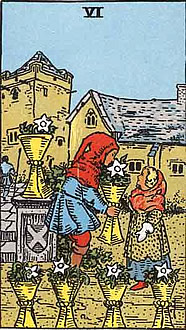Tarot Card for the Week of 8-17-14
The tarot cards hold special meanings, warnings, characteristics and actions that may need to be taken in order to change your course in life. Keep in mind that some aspects are changeable and some are not. It is all up to you. With the Six of Cups as the tarot card for the week of 8-17-14, this may be the week you will take a trip memory lane or revisit some childhood memories. Doing that can be a positive experience and reminiscing may bring you inner peace, joy and happiness. However, you may realize this week that you have been stuck in the past and unable to move forward. It is time to let go. Take a hard look at your lifestyle this week, especially if you have been feeling depressed and hopeless. Putting yourself under the microscope every now and then can bring about positive change. This may also be the week that an old friend or lover from your past pays you a surprise visit, lends you a hand, or remembers a kindness you once bestowed upon them. You may also come to realize that some of your relationships may only be temporary. An old acquaintance may provide you with contacts for a new career opportunity or perhaps even a move is involved. The exotic trip you have been planning for a long time may come to fruition this week.

UPRIGHT: The Six of Cups, Minor Arcana, signifies nostalgia ? revisiting memories of events and people from the past. It is healthy to revisit your past so you can understand yourself in the here and now. However, don’t retreat into those happier memories to escape the present challenges you may be facing. This card also symbolizes the childhood innocence and naivete you once had, which can indicate your detachment from adult responsibility or your longing for the safety and security of childhood. You may have blinders on when in comes to a relationship ? business or personal. Childhood friends might positively influence your future. There might also be a physical trip down memory lane ? a visit to your old stomping grounds. Perhaps you will reconnect with an old acquaintance.
REVERSED: Living too much in the past and/or for the past, and harboring bad memories or events is blocking your progress. Because of this you can be missing out on new opportunities and relationships. You might see your past experiences in one light, while others may see it quite differently. These sad memories are filling you head with negativity in the present. Give yourself a fresh start and put those negative memories behind you. Stop the flow of bad energy. This can also symbolize that you suffered some form of abuse as a child and you are having difficulty letting go of those memories. You might find yourself in some form of a support group. It may be a sign of fertility problems, difficulty with an adoption or disciplinary problems with a child. You may be harboring anger and frustration because you did not realize your childhood dreams.
TO LEARN MORE ABOUT THE TAROT,
PLEASE VISIT THE TAROT ROOM.
TO SHARE THIS POST ON SOCIAL MEDIA,
PLEASE CLICK THE “READ MORE” BUTTON BELOW.
Read More »
Psychomanteum: Spirits Through a Looking Glass
?
?
?
?
?
?
?
?
A psychomanteum is a small, dark chamber used to facilitate communication with a particular departed soul. Its origin stem from an ancient Greek ritual for contacting those in the spirit realm. At that time, individuals were led through an underground maze to a dimly lit place so they would be away from outside stimuli. In that area was a cauldron or bowl filled with water or oil. The person would gaze directly into the cauldron, look at and focus on his own reflection in the hope that the spirit would appear.
This was actually an early form of scrying, which is a type of divination used to predict the future by gazing into a crystal ball (crystallomancy), other shiny object or reflective surface. Reflective surfaces were believed to be a portal to the spirit world. Throughout ancient history, many cultures have used other methods, using herbs, plants, smoke or drumming, to induce an altered state of mind to achieve a higher consciousness in order to contact spirits for guidance, to answer questions, to heal and to connect with ancestors who had passed.
The earliest known term used for these chambers was psuchomanteia. In the 20th century, Raymond Moody, M.D., Ph.D., grief counselor, respected researcher in near-death experiences and author of Life after Life and other works, was inspired by the writings of Herodotus about the Oracle of the Dead and Homer in The Odyssey, in which they described these chambers. Moody believed that such a chamber would help individuals through the grieving process after the death of a loved one or friend. The time spent contacting and connecting with those in the spirit realm would help or create a powerful impact on emotional healing. Moody recreated a modern-day chamber and called it a psychomanteum. Currently, his work in the field continues, and he lectures, consults and researches on this topic, as well as others.
Moody?s psychomanteum chamber was a small, dimly lit room (approximately the size of a walk-in closet) with a mirror on one wall and a comfortable chair directly facing the mirror. It was intentionally hung so that the individual sitting in the chair was unable to see his or her own reflection. This was not the case in ancient psychomanteums, in which the individual stared at his own reflection while gazing into a reflective surface. Placed behind the chair was a lamp with a low-wattage bulb. Additionally, a black velvet curtain surrounded the chair to create a nestled and secure environment for the individual. Doing that was a form of sensory deprivation, which was used to block all external stimuli, thus allowing the mind of the individual sitting in the chair to focus only on the intended spirit that was to be contacted.
Before participating in the initial chamber testing, a rigorous selection process for potential subjects was put in place. Moody devised specific methods to prepare the selected participants for the experience. He encouraged them to dress in comfortable attire, to bring an object or picture that evoked strong memories of the deceased and to share their deepest feelings and experiences with him, either positive or negative. Moody continued to relax the participants by walking leisurely and talking about the grieving process and the expectations of the psychomanteum experience. To get his subjects even more relaxed and get them closer to a true meditative state, he had them also lie down and listen to soft music before entering the chamber.
The actual time spent in the psychomanteum was a mere 45 minutes to one hour, while in comparison, the preparation for it took quite a few hours. After each session in the room ended, he would discuss the experience in-depth with the participant.
Moody never guaranteed a connection with those who had passed during the time in the psychomanteum. People?s experiences within the chamber varied. In some cases, the spirit that the person hoped to contact did in fact appear to deliver a message, some final words or just some extra time that was needed between the two. In other cases, another spirit who had a relationship with the person appeared and offered similar comfort or an important message.
Sometimes, subjects experienced a feeling that a comforting presence was in the room, being touched by the apparition ? a consoling hug, a gentle stroke on the hand or face, or the spirit appearing as if it were once again in human form. Moody reported that regardless of what did or did not ?appear? from the spirit realm during the time spent in the room, the subjects had positive reactions to it and felt comforted, at peace and gained much needed closure regarding the passing of their departed.
Today, the purpose of the psychomanteum has been expanded to include not just bereavement and contacting spirits. It has become a key tool in helping people to attain a greater knowledge of the Self and to provide the ability to achieve a higher consciousness, which can aid in clarifying change and major life decisions.
TO LEARN MORE ABOUT AFTER-DEATH COMMUNICATION,
PLEASE VISIT THE OTHER SIDE.
TO SHARE THIS POST ON SOCIAL MEDIA,
PLEASE CLICK THE “READ MORE” BUTTON BELOW.
?
Read More »

